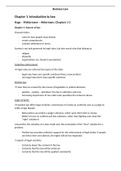Business Law
Chapter 1: Introduction to law
Hage – Waltermann – Akkermans: Chapters 1-3
Chapter 1: Sources of law
Characteristics:
- rules for how people must behave
- create competencies
- contains definitions of terms.
Society is not only governed by legal rules, but also moral rules that belong to:
- religion
- etiquette
- organizations (ex. Student associations)
Collective enforcement
legal rules are enforced by organs of the State
- legal rules have very specific sanctions (fines, incarceration)
- non-legal rules don’t have specific sanctions
Positive law
laws that are created by the means of legislation or judicial decisions
- positive – positus – laid down: the law is valid here and now
- increasing importance of non-state rules questions the sentence above.
Legal certainty
positive law offers legal certainty: unnecessary to invoke an authority such as a judge to
settle a legal dispute.
- Both parties can predict a judge’s decision, which saves them time & money
- Better to have no conflicts and fast solutions, rather than fighting over what the
“right” solution is
Law prefers the certainty of a clear result over the uncertainty of the “best” solution for a
problem.
- Positive law provides collective support for the enforcement of legal duties: if people
are left to their own devices, the rights will be less respected.
3 aspects of legal certainty:
- Certainty about the content of the law
- Certainty that the law will be enforced
- Certainty that the law will be applied consistently
, Business Law
Roman law (8th century BCE – 6th century CE)
Tribal customary law
Nowadays, laws are for a particular country (German law – English law) or European law for
the countries in the European Union.
Public international law: a body of law that existed to govern the relations between States
Roman law was not the law of a country or state, but the law of people (Roman people):
- tribal law: law made by a tribal group connected by family ties
- customary law: law that consists guidelines for behavior that have grown
spontaneously in a society in the form of mutual experiences.
When a rule is repeated over e period of time, it will be taken serious with the
consequences of punishments for one party.
- Customary law is taken to be immutable: law was such since time immemorial and
will never change. BUT customary law starts as unwritten, so it changes over time
because there are unnoticed changes made by people.
Even though it slowly changes over time, its image of being natural and immutable may
remain intact.
- Customary law is ascribed to a legislator, but not the result of legislation
- Not easily distinguishable from the religious and moral precepts a separation
between church and state (not accepted in Islamic law)
Codification
codified laws are written laws
Customary law started as unwritten law
451 BCE “Twelve Tables”: part of Roman law written down because otherwise it could be
interpreted wrong by the ‘pontiffs’ (cast of ‘patricians’ – upper class) and it would be in the
disadvantage of the ‘plebeians’ (lower social class)
If customary law is written down = having been codified, more difficult to manipulate the
law to the advantage of a few.
! Law that was codified already existed before the codification, while law that was created
through legislation did not exist before it was written down !
Nowadays codified laws are laws contained in legislation
, Business Law
Corpus Iuris Civilis
395BCE – Roman Empire became western and eastern halves
Western Empire – plunder of Rome in 455 CE by Germans
Eastern Empire – survived until Turkish Ottoman Empire invasion in 1453
before that, Eastern Empire reached a cultural summit with the Corpus Iuris Civilis:
- Corpus: attempt to codify existing Roman law published on order of Justinianus from
529-534
- 1st part = the codex: contained imperial legislation spanning several centuries
- 2nd part = the digest: collection of excerpts from writing of jurists (100 BCE – 300 CE)
- 3rd part = the institutions: student textbook
Common law
After fall Western Roman Empire, the law returned to customary tribal law, namely to the
law of German tribes.
In the High Middles Agers (11th – 15th century), several developments took place in Europe:
- Rediscovery of roman law: Roman law turned out to be very influential on the
development of private law on the European continent. (not in England)
Royal justices
Common law as a separate legal system: 1066 – Norman King William I
He invaded and conquered England. A movement towards the unification of the English
legal system as result. (consisted local customary law)
- A system of royal representatives with the task to apply the same law everywhere,
that law would become the Common Law of England
- Uniform legal system left the English law largely unaffected.
- English legal system developed independently
Continental legal reasoning focuses on the creation and the application of statutory rules,
while the emphasis in the common law tradition has been on reasoning by way of analogy
to previous cases consequence of the doctrine of stare decisis
Precedent
Customary rules come into being if they are used by judges etc. The decision of the judge
will function as a precedent for future cases and will be considered customary law.
Two ways to interpret this:
- The decision of the judge is evidence of the law already existing before the judge
gave his decision
- The judge created a rule that did not exist yet, but will exist from that moment on.
The court’s decision create the law rather then state it used in 20th century
Chapter 1: Introduction to law
Hage – Waltermann – Akkermans: Chapters 1-3
Chapter 1: Sources of law
Characteristics:
- rules for how people must behave
- create competencies
- contains definitions of terms.
Society is not only governed by legal rules, but also moral rules that belong to:
- religion
- etiquette
- organizations (ex. Student associations)
Collective enforcement
legal rules are enforced by organs of the State
- legal rules have very specific sanctions (fines, incarceration)
- non-legal rules don’t have specific sanctions
Positive law
laws that are created by the means of legislation or judicial decisions
- positive – positus – laid down: the law is valid here and now
- increasing importance of non-state rules questions the sentence above.
Legal certainty
positive law offers legal certainty: unnecessary to invoke an authority such as a judge to
settle a legal dispute.
- Both parties can predict a judge’s decision, which saves them time & money
- Better to have no conflicts and fast solutions, rather than fighting over what the
“right” solution is
Law prefers the certainty of a clear result over the uncertainty of the “best” solution for a
problem.
- Positive law provides collective support for the enforcement of legal duties: if people
are left to their own devices, the rights will be less respected.
3 aspects of legal certainty:
- Certainty about the content of the law
- Certainty that the law will be enforced
- Certainty that the law will be applied consistently
, Business Law
Roman law (8th century BCE – 6th century CE)
Tribal customary law
Nowadays, laws are for a particular country (German law – English law) or European law for
the countries in the European Union.
Public international law: a body of law that existed to govern the relations between States
Roman law was not the law of a country or state, but the law of people (Roman people):
- tribal law: law made by a tribal group connected by family ties
- customary law: law that consists guidelines for behavior that have grown
spontaneously in a society in the form of mutual experiences.
When a rule is repeated over e period of time, it will be taken serious with the
consequences of punishments for one party.
- Customary law is taken to be immutable: law was such since time immemorial and
will never change. BUT customary law starts as unwritten, so it changes over time
because there are unnoticed changes made by people.
Even though it slowly changes over time, its image of being natural and immutable may
remain intact.
- Customary law is ascribed to a legislator, but not the result of legislation
- Not easily distinguishable from the religious and moral precepts a separation
between church and state (not accepted in Islamic law)
Codification
codified laws are written laws
Customary law started as unwritten law
451 BCE “Twelve Tables”: part of Roman law written down because otherwise it could be
interpreted wrong by the ‘pontiffs’ (cast of ‘patricians’ – upper class) and it would be in the
disadvantage of the ‘plebeians’ (lower social class)
If customary law is written down = having been codified, more difficult to manipulate the
law to the advantage of a few.
! Law that was codified already existed before the codification, while law that was created
through legislation did not exist before it was written down !
Nowadays codified laws are laws contained in legislation
, Business Law
Corpus Iuris Civilis
395BCE – Roman Empire became western and eastern halves
Western Empire – plunder of Rome in 455 CE by Germans
Eastern Empire – survived until Turkish Ottoman Empire invasion in 1453
before that, Eastern Empire reached a cultural summit with the Corpus Iuris Civilis:
- Corpus: attempt to codify existing Roman law published on order of Justinianus from
529-534
- 1st part = the codex: contained imperial legislation spanning several centuries
- 2nd part = the digest: collection of excerpts from writing of jurists (100 BCE – 300 CE)
- 3rd part = the institutions: student textbook
Common law
After fall Western Roman Empire, the law returned to customary tribal law, namely to the
law of German tribes.
In the High Middles Agers (11th – 15th century), several developments took place in Europe:
- Rediscovery of roman law: Roman law turned out to be very influential on the
development of private law on the European continent. (not in England)
Royal justices
Common law as a separate legal system: 1066 – Norman King William I
He invaded and conquered England. A movement towards the unification of the English
legal system as result. (consisted local customary law)
- A system of royal representatives with the task to apply the same law everywhere,
that law would become the Common Law of England
- Uniform legal system left the English law largely unaffected.
- English legal system developed independently
Continental legal reasoning focuses on the creation and the application of statutory rules,
while the emphasis in the common law tradition has been on reasoning by way of analogy
to previous cases consequence of the doctrine of stare decisis
Precedent
Customary rules come into being if they are used by judges etc. The decision of the judge
will function as a precedent for future cases and will be considered customary law.
Two ways to interpret this:
- The decision of the judge is evidence of the law already existing before the judge
gave his decision
- The judge created a rule that did not exist yet, but will exist from that moment on.
The court’s decision create the law rather then state it used in 20th century





